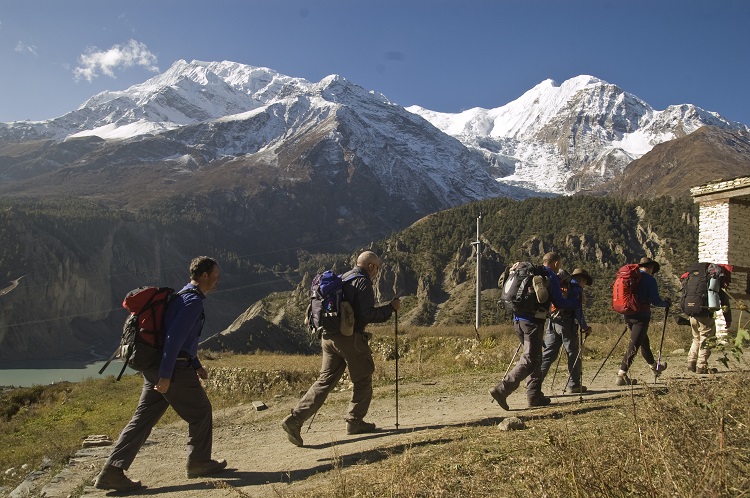
No visitor to Kathmandu’s Thamel or Pokhara’s Lakeside this past tourist season (from September to November) could have failed to notice unusually big crowds of foreign visitors compared to the same time in previous years. The year 2017 was indeed a high-water mark for Nepali tourism as a record number of foreign tourists came calling. The Department of Immigration data shows a total of 940,693 tourists visited Nepal in 2017, easily surpassing the previous record of 803,092 in 2012. If we factor in tourist arrivals by various land routes, the 2017 figure will easily cross one million, according to the Nepal Tourism Board (NTB).
There has in fact been a steady uptick in the number of foreign tourists since the low of 2015, when, due to the earthquakes and the border blockade, just 538,970 of them visited Nepal.
The top-five tourist-contributing countries in 2017 were: India (160,832), China (104,664), the US (79,146), the UK (51,058) and Sri Lanka (45,361).
The tourism board deserves some credit. It has in recent times made a concerted effort to promote Nepal abroad. In April 2017 it signed up to promotion schemes with the BBC, Trip Advisor and Reuters. The board also initiated online and TV promotional campaigns in different parts of the world. Nepal, for instance, participated in the 21st East Mediterranean International Tourism and Travel Exhibition (EMITT) in Istanbul, allowing the country to showcase its tourist attractions in the Middle East for the first time.
Another successful promotional campaign was the first-of-its-kind ‘International Photography Competition on Nepal’ held in the Chinese city of Chengdu in December, 2017. At least 600,000 Chinese and foreign tourists visited the exhibit of photos related to tourism, art and culture of Nepal.
“We have been rigorous in promoting Nepal abroad following the 2015 earthquakes,” says Sunil Sharma, officiating director, PR and publicist branch of the NTB. “Not just the NTB, tourism entrepreneurs, other responsible government bodies, our industries, each became an unofficial brand ambassador for the country”. Brand Nepal also got a fillip when the country was voted the second ‘Best Travel Destination’ in ‘Adventure Travel’ category of the 2017 National Geographic Travelers Award.
Nepal relies heavily on tourism. According to the World Travel and Tourism Council (WTTC), in 2017 tourism accounted for 7.5 percent of Nepal’s GDP, and the country was ranked 37th, among the 185 countries surveyed on tourism’s direct contribution to GDP. In 2017 tourism supported 427,000 jobs in Nepal.
The mood among hoteliers is upbeat. “We had 81 percent room occupancy in 2016,” said Phurba Sherpa, Director, sales and marketing for Hotel Shangri-la. “In 2017, occupancy went up to 87 percent and in the first quarter of 2018 we are already expecting 91 percent of occupancy.”
Yet there are skeptics who argue that new tourist numbers should be put into perspective. For instance, according to the Hotel Association of Nepal, overall hotel room occupancy in 2017 was just 60 percent, the same as in 2016. This is because more and more hotels are being opened, says Binayak Shah, the association’s general secretary. “We currently have the capacity to accommodate 1.6 million tourists but only around 1 million came at the peak of 2017. The supply far outstrips demand.”
On the other hand, says Tek Mahat, the CEO of Trekking Agencies’ Association of Nepal, hotel occupancy gives only partial picture of tourist interest, as it does not factor in the tremendous growth in village tourism and home-stay option. “We have for instance been trying to connect tourists with people of Annapurna and Everest regions. Tourists value this opportunity to get to know Nepalis and their habits up close,” says Mahat.
Nepal has the potential to welcome even more tourists. After all, “a tourist who comes to trek in Nepal won’t get the same experience anywhere else in the world,” says Sharma of NTB.
With its ‘Tourism Vision 2020’ Nepal plans to bring two million tourists by 2020. But delays in construction of vital tourism-supporting infrastructures like the second international airport in Nijgadh, Bara and the regional international airport in Pokhara make the task difficult. Nepal’s only international airport is crowded and mismanaged. The condition of the roads and highways is no better. Nepal has a lot going for it, say tourism entrepreneurs, but it would be dangerous to relax, as the competition for foreign tourists in South Asia is stiff.











